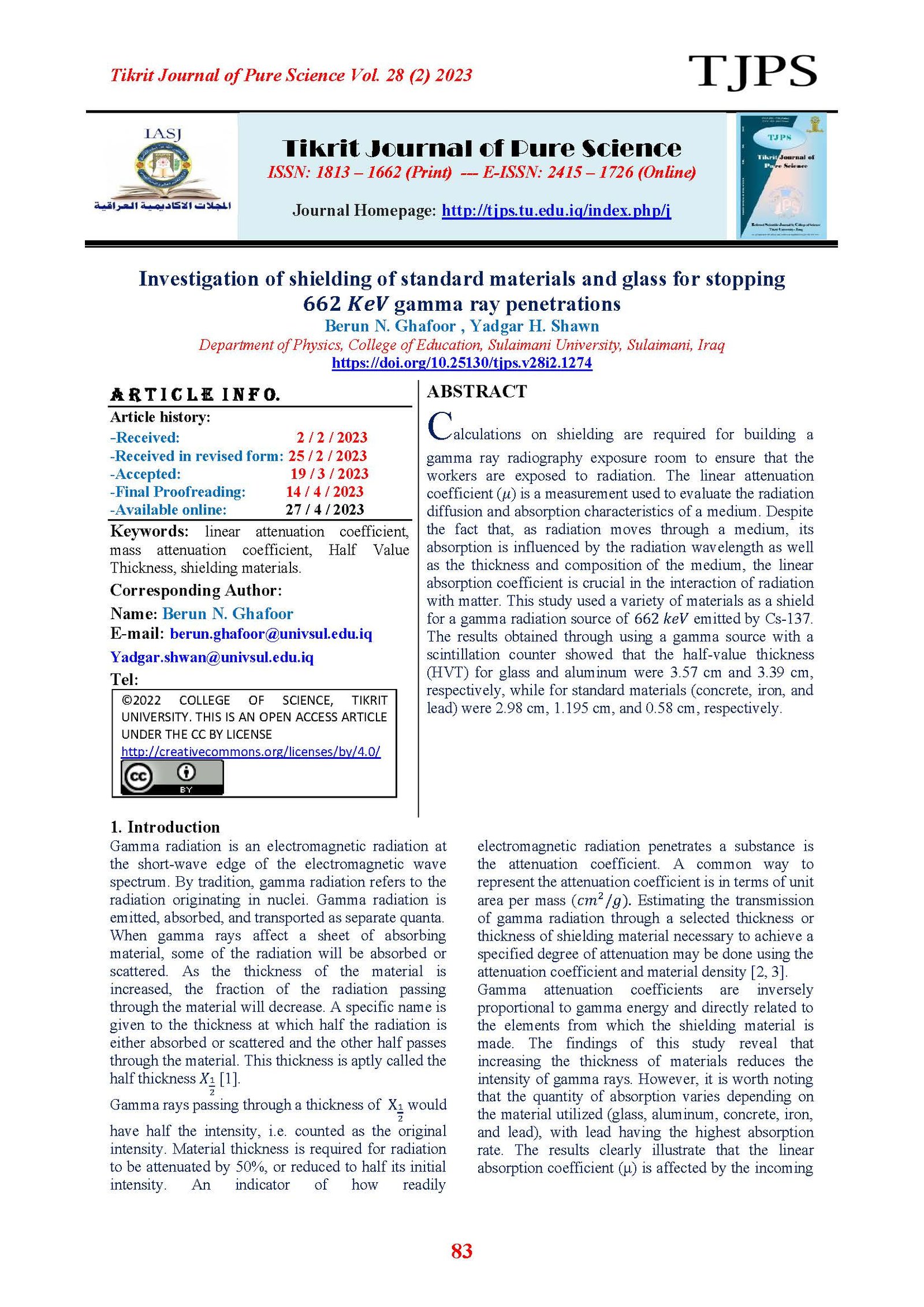Investigation of shielding of standard materials and glass for stopping 662 KeV gamma ray penetrations
Main Article Content
Abstract
Calculations on shielding are required for building a gamma ray radiography exposure room to ensure that the workers are exposed to radiation. The linear attenuation coefficient ( ) is a measurement used to evaluate the radiation diffusion and absorption characteristics of a medium. Despite the fact that, as radiation moves through a medium, its absorption is influenced by the radiation wavelength as well as the thickness and composition of the medium, the linear absorption coefficient is crucial in the interaction of radiation with matter. This study used a variety of materials as a shield for a gamma radiation source of emitted by Cs-137. The results obtained through using a gamma source with a scintillation counter showed that the half-value thickness (HVT) for glass and aluminum were 3.57 cm and 3.39 cm, respectively, while for standard materials (concrete, iron, and lead) were 2.98 cm, 1.195 cm, and 0.58 cm, respectively.
Article Details

This work is licensed under a Creative Commons Attribution 4.0 International License.
Tikrit Journal of Pure Science is licensed under the Creative Commons Attribution 4.0 International License, which allows users to copy, create extracts, abstracts, and new works from the article, alter and revise the article, and make commercial use of the article (including reuse and/or resale of the article by commercial entities), provided the user gives appropriate credit (with a link to the formal publication through the relevant DOI), provides a link to the license, indicates if changes were made, and the licensor is not represented as endorsing the use made of the work. The authors hold the copyright for their published work on the Tikrit J. Pure Sci. website, while Tikrit J. Pure Sci. is responsible for appreciate citation of their work, which is released under CC-BY-4.0, enabling the unrestricted use, distribution, and reproduction of an article in any medium, provided that the original work is properly cited.
References
[1] Qadr, H. M. (2019). Calculation for gamma ray buildup factor for aluminium, graphite and lead. International Journal of Nuclear Energy Science and Technology, 13(1), 61-69. DOI: 10.1504/IJNEST.2019.10020880 [2] Taqi, A. H., & Khalil, H. J. (2017). Experimental and theoretical investigation of gamma attenuation of building materials. Journal of Nuclear and Particle Physics, 7(1), 6-13, doi:10.5923/j.jnpp.20170701.02 [3] Böke, A. (2014). Linear attenuation coefficients of tissues from 1 keV to 150 keV. Radiation Physics and Chemistry, 102, 49–59, DOI: 10.1016/j.radphyschem.2014.04.006 [4] Al-Khawlany, A., Pathan, J. M. & Fatema, I. (2020). Determination of attenuation coefficients of some selected soil samples by using gamma energy at 0.360 Mev. To Chemistry Journal, 6, 9-15. [5] Elawi, M. A., Khalil, K. & Hamad, D. K. (2017). Comparison of gamma–rays attenuation measured by direct and coincidence spectra. Tikrit Journal of Pure Science, 22(12), 98-108. DOI: https://doi.org/10.25130/tjps.v22i12.936 [6] Elawi, M. A., Abbas, L. A., & Salih, S. A. (2017). Use of gamma–gamma coincidence technique in investigating gamma–rays attenuation at different energies. Tikrit Journal of Pure Science, 22(12), 118-125. DOI: https://doi.org/10.25130/tjps.v22i12.938 [7] Al-Ghreer, A. Z., & Abdualla, Z. A. (2016). A comparative study between the two interferon gamma releasing assays in the diagnosis of pulmonary tuberculosis. Tikrit Journal of Pure Science, 21(3), 1-6. DOI: https://doi.org/10.25130/tjps.v21i3.1016 [8] Al-Dhuhaibat, M. (2015). Study of the shielding properties for some composite materials manufactured from polymer epoxy supported by cement, aluminum, iron and lead against gamma rays of the cobalt radioactive source (Co-60). International Journal of Application or Innovation in Engineering & Management (IJAIEM), 4(6), 90-98.
[9] Gjorgieva, S. & Lambe Barandovski, L. (2016). Measurement of the mass attenuation coefficient from 81 keV to 1333 keV for elemental materials Al, Cu and Pb. 9th International Physics Conference of the Balkan Physical Union (BPU-9), AIP Conf. Proc. 1722, 180003-1–180003-4; doi: 10.1063/1.4944211 [10] Mavi, B., Oner, F., & Akkurt, I. (2015). Determination of gamma-ray attenuation coefficients at different energies in Amasya marbles. Acta Physica Polonica A, 128(2B), B-395-B-396. DOI: 10.12693/APhysPolA.128.B-395 [11] Khanna, A., Bhatti, S. S., Singh, K. J., & Thind, K. S. (1996). Gamma-ray attenuation coefficients in some heavy metal oxide borate glasses at 662 keV. Nuclear Instruments and Methods in Physics Research Section B: Beam Interactions with Materials and Atoms, 114(3-4), 217-220, https://doi.org/10.1016/0168-583X(96)00196-6 [12] Singh, N., Singh, K. J., Singh, K., & Singh, H. (2006). Gamma-ray attenuation studies of PbO–BaO–B2O3 glass system. Radiation measurements, 41(1), 84-88, https://doi.org/10.1016/j.radmeas.2004.09.009
